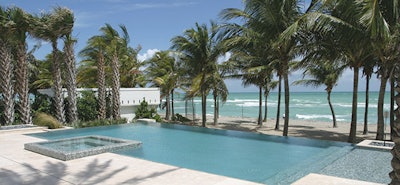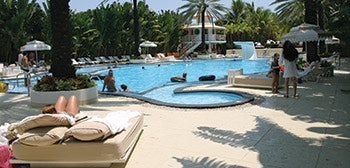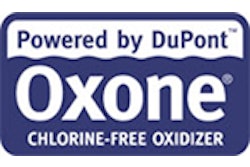



Of the major swimming pool markets in the U.S., Florida has been and remains one of the bellwether states most associated with all things aquatic. Here, Florida native and industry pioneer Brian Van Bower looks back at his personal and professional experiences that have influenced not only his work, but also a life spent in pursuit of the luxurious lifestyle long associated with his home state.
The great state of Florida is known for many things — oranges, alligators, hurricanes — but it’s also recognized as one of largest swimming pool markets in the U.S. with an estimated 1.2 million residential and commercial pools.
One of the most identifiable aspects of Florida culture is proximity to water — the state boasts the longest coastline in the contiguous 48 states at 1,350 miles. As a result, aquatic activities abound including fishing, scuba diving, waterskiing, sunbathing and all manner of swimming-related behavior.
Nowhere has that been more apparent than in my hometown of Miami, where the iconic hotels along Miami Beach once led the way in terms of promoting a luxurious outdoor lifestyle anchored by swimming pools. Back in the ’20s and ’30s, the resorts on Miami Beach were famous for hosting the rich and famous as well as featuring theatrical aquatic productions. And all of that was long before the post World War II era gave rise to the middle class residential pool market.
The ubiquitous nature of water in the Sunshine state also means that Floridians have become accustomed to dealing with the hazards that come with it. For example, many of the pools here are famously screen enclosed, largely to avoid the nuisance of insects and the potentially dangerous presence of snakes and alligators. And it bears mentioning that we get hit by hurricanes more than any other state in the union.
Much of the state has a high water table, which can complicate the pool installation process, and being largely flat — the highest point in the state is a mere 345 feet above sea level — we don’t enjoy the kind of scenic topography found in other states that result in spectacular hillside installations. Still, if you ask me, inside our industry and outside of it, whatever drawbacks there might be, living and doing business here is more than worth it.
Like many areas of the country, the residential pool industry in Florida came on strong in the 1950s and ’60s with the expansion of suburbia. Back when I was a kid during that timeframe, my grandparents bought a home with a pool in what at the time was a nice middle-class neighborhood. The pool was screened in and just a basic kidney shape, but to my brother and me it was like paradise on earth.
I’ll never forget how excited we were. When the pool was being filled, my brother and I were in the bottom in about a foot and a half of water. It was just the beginning of many years having fun in that pool. Little did I know at the time that those formative experiences swimming in pools would someday serve as an emotional foundation for my career.
BUFFALO SANDALS
My involvement in the industry dates back to my very early adult years, during a time when I was far more interested in the pretty women that adorn our beaches and pool decks than I was with the nuances of custom pool construction and design.
It was 1969; I was 20 and landed a job at the Suez Motel on Miami Beach as the assistant pool manager. My buddy and I worked a pool manager named Frenchy. After my friend and Frenchy left for other jobs, I became the pool manager, a role that put me in charge of running and maintaining the property’s two swimming pools.
That job was a perfect fit with my freewheeling love of the good life. I walked to work every day in my bathing suit and Buffalo sandals and spent my days not only taking care of the pools, but also seeing to the creature comforts of the largely French-Canadian hotel guests. I set out the lounge cushions, opened and closed umbrellas, swept the decks, set up the beach area, played guitar for the hotel guests and conducted scuba diving lessons in one of the pools. And I was always willing to rub suntan oil on the backs of any female guest who asked.

I was truly living the Florida dream.
It was also the beginning of my education in how swimming pools work. One of those pools was sanitized with gas chlorine, which I knew nothing about at the time. I meticulously cleaned the pools, emptied the gutters and pump baskets and maintained the sand filters. Looking back, it’s a little shocking what I didn’t know, but I happily muddled through.
After my work at the Suez, I took my involvement in the industry to the next step with a full-time job working for a local service company. I learned a lot about the industry and pool systems in those days, but eventually had a falling out with the owner. That led me to take a similar position with a competing company.
It was sometime around then I realized I wanted to stay in the industry, I liked working outside, really enjoyed pools and started to see them as a career path. It didn’t hurt that while working on Miami Beach, I was exposed to higher end pools for affluent clients. While those vessels weren’t nearly as elaborate as some of today’s custom installations, they were far more luxurious and interesting than the production level pools that dominated most of the market in those days.
To make a long story short, I decided to strike out on my own and start my own company. While it started out of my home initially, over time we added accounts and employees and grew to 20 employees with more than 500 pools on service. We had our company MO, which was all about quality service, and we also charged more than other companies because we were doing a better job than the competition. I also eventually opened a retail shop in conjunction with the service business, a useful experience in learning that side of the industry.
As is the case for other people I know in this business — some who have wound up as custom builders and members of the Genesis 3 family — I progressively moved into repairs, then remodels and eventually original construction.
CUSTOM EVOLUTION
Through all these years, I never lost sight of my roots in the service business. Even to this day, when I’m working with wealthy clients on extremely complex designs, I tell them that while I want to design interesting aquatic environments that are creative and visually beautiful, I also want them to function reliably and be easy to service.
The problem I ran into back in my early days as a builder was that most of my colleagues hadn’t yet embraced the idea of reaching beyond the cookie cutter mode of construction. Like many other regions of the country, the Florida pool industry started out, and for many remains, a production-oriented concept. Although I do acknowledge that there’s a place for comparatively inexpensive pools, I could see far greater potential in the market.
For example, the very first pool I built was already somewhat outside the box. It was located on Miami Beach, a piling pool right on the water. By today’s standards it wasn’t all that unusual, but back then the design was certainly ambitious. It was a pool/spa combo with a rock treatment that rose out of the water and became the wall between the pool and the spa as well as a waterfall. It also had an early version of an electronic control system called the Time Master, made by Compool for Jandy.
During construction, I sought the advice of a local pool builder who had a good reputation. He took a look at the pool when it was in progress and asked me what I charged the client. Looking back, I think the price tag was somewhere in the $25,000 range. When I shared that number with this gentleman, he didn’t believe me. He thought it was impossible that anyone could ever convince a client to pay that much for a pool.
He asked me how I came up with the price to which I simply explained that I added up all the stuff we’d included on the job and then added what I thought was a reasonable profit. I told the customer the price and they gave me the money. He still didn’t believe me.
It was at that point I started to think that there was far more in this field could offer in both income and creative possibilities.

I ran into the same issue in 1991 when I sold my service business and no one believed what I was charging our clients. Again, that experience reinforced my belief that our industry was overall selling itself short.
Fortunately, I would soon discover that the Florida market was, indeed, ripe for a more advanced level of pool environment.
INTO THE LAGOON
For a time back in my early days of pool design and construction, I became somewhat pigeonholed as a designer of “lagoon” pools. I remain proud of the fact that I, and a handful of other builders, were at forefront of that style.
It started with my own pool. I had a vision of building pools that reflected the lush, tropical atmosphere, but I had trouble selling the concept because no one really knew what I meant. So I decided to build one in my own home.
It turned out really well. It had a freeform shape, lots of rockwork including a large waterfall, lush plantings, a Tiki hut with a raised wood deck cantilevered over the water with a rope swing, another Tiki hut in another area for entertaining, torches and the overall the feel that you were in a tropical setting by a natural body of water.
A pool builder and friend of mine who had become the executive director of the state pool association, Larry Bellanger, visited our home when it was finished and said it was the coolest pool he’d ever seen. My local pool builder friend, Phil Whittaker, built a similar style pool in his own backyard with several waterfalls, the Tiki hut and all the details you associate with naturalistic designs. As it happened, that year’s NSPI international expo was held in Miami. Phil and I both entered our lagoon pools in the design award and both won gold.
From that point on, I was able to use my pool as an example of the concept, and all of a sudden it was what many customers wanted. We wound up building a bunch of them to the point where I actually became tired of the genre after a few years. It was certainly a perfect fit with the Florida lifestyle and attitude and continues as a popular choice to this day for clients in Florida and elsewhere. (In fact, we’re currently designing an elaborate one in West Virginia with a swim-up bar, beach entry, multiple waterfalls and wildly freeform shape.)
Art Deco is another genre associated with Florida and Miami Beach in. The style was popularized by the aforementioned hotels along Miami Beach during the pre-World War II era, back when pools were strictly for the rich and famous. In many respects, those early to mid-20th century properties were among the first to use their pool environments as promotional centerpiece.
One of the most iconic pools in that genre and from that era is still in operation at the famous Raleigh Hotel. Back in the early ’90s I had the privilege of remodeling of that famous pool, creating a system of shallow lounging areas and generally updating the system among several other improvements.
It was a great project and a thrill to help perpetuate a style of design that is so closely identified with southern Florida. The pool at the Raleigh has been used as a set for movies, fashion photo shoots and rock videos.
WORKING THE SPECTRUM
These days, those particular design motifs remain popular and probably forever associated with the state. But as the custom end of the market has expanded over the past two to three decades, the lagoon and Art Deco pools have been joined by all manner of contemporary and classical designs. We’ve seen the proliferation of the vanishing edge, perimeter overflow systems and all-tile pools, along with ever-greater integration of pools with the surrounding landscape and architecture.
What hasn’t changed and hopefully never will has been the sunshine-loving attitude among Floridians and the countless people who come to visit. It’s in our blood and for my part, no matter how long I’ve been at this work, I still feel connected and inspired by my personal and professional experiences that will always remain very much a reflection of the Florida sun.
Comments or thoughts on this article? Please e-mail [email protected].











































